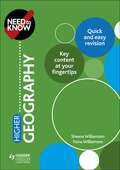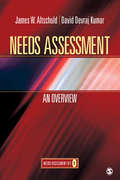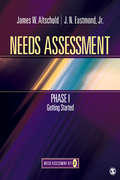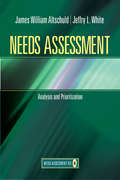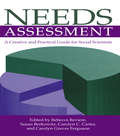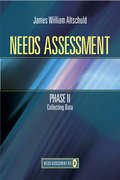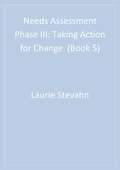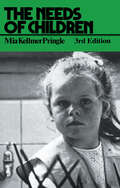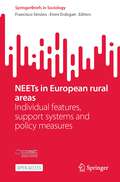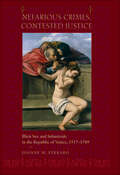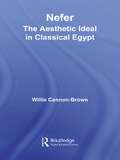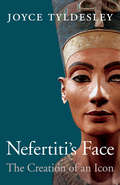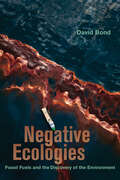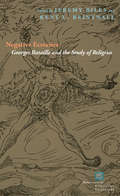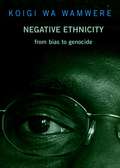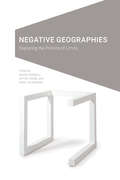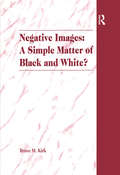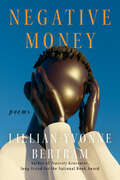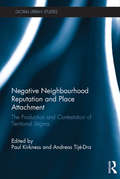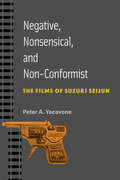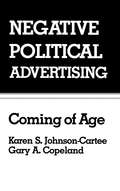- Table View
- List View
Need to Know: Higher Geography
by Sheena Williamson Fiona WilliamsonExam board: SQALevel: HigherSubject: GeographyFirst teaching: September 2018 First exams: Summer 2019 What do you really need to know for the SQA Higher Geography exam?This revision guide covers the essentials in less than 90 pages, so it's perfect for early exam preparation or last-minute revision.- Find key content at your fingertips with quick summaries of the processes, issues and terminology that you need to understand- Get a better grade in your exam with tips on exam technique, mistakes to avoid and important things to remember- Revise and practise using end-of-topic questions and synoptic questions at the end of each section - with answers provided onlineThis book covers all topics except for Energy from the Global Issues component.
Need to Know: Higher Geography
by Sheena Williamson Fiona WilliamsonExam board: SQALevel: HigherSubject: GeographyFirst teaching: September 2018 First exams: Summer 2019 What do you really need to know for the SQA Higher Geography exam?This revision guide covers the essentials in less than 90 pages, so it's perfect for early exam preparation or last-minute revision.- Find key content at your fingertips with quick summaries of the processes, issues and terminology that you need to understand- Get a better grade in your exam with tips on exam technique, mistakes to avoid and important things to remember- Revise and practise using end-of-topic questions and synoptic questions at the end of each section - with answers provided onlineThis book covers all topics except for Energy from the Global Issues component.
The Needle and the Lens: Pop Goes to the Movies from Rock 'n' Roll to Synthwave
by Nate PatrinHow the creative use of pop music in film—think Saturday Night Fever or Apocalypse Now—has shaped and shifted music history since the 1960s Quick: What movie do you think of when you hear &“The Sounds of Silence&”? Better yet, what song comes to mind when you think of The Graduate? The link between film and song endures as more than a memory, Nate Patrin suggests with this wide-ranging and energetic book. It is, in fact, a sort of cultural symbiosis that has mutually influenced movies and pop music, a phenomenon Patrin tracks through the past fifty years, revealing the power of music in movies to move the needle in popular culture. Rock &’n&’ roll, reggae, R&B, jazz, techno, and hip-hop: each had its moment—or many—as music deployed in movies emerged as a form of interpretive commentary, making way for the legitimization of pop and rock music as art forms worthy of serious consideration. These commentaries run the gamut from comedic irony to cheap-thrills excitement to deeply felt drama, all of which Patrin examines in pairings such as American Graffiti and &“Do You Want to Dance?&”; Saturday Night Fever and &“Disco Inferno&”; Apocalypse Now and &“The End&”; Wayne&’s World and &“Bohemian Rhapsody&”; and Jackie Brown and &“Didn't I Blow Your Mind This Time?&”. What gives power to these individual moments, and how have they shaped and shifted music history, recasting source material or even stirring wider interest in previously niche pop genres? As Patrin surveys the scene—musical and cinematic—across the decades, expanding into the deeper origins, wider connections, and echoed histories that come into play, The Needle and the Lens offers a new way of seeing, and hearing, these iconic soundtrack moments.
Needles, Herbs, Gods, and Ghosts: China, Healing, and the West to 1848
by Linda L. BarnesWhen did the West discover Chinese healing traditions? Most people might point to the "rediscovery" of Chinese acupuncture in the 1970s. In Needles, Herbs, Gods, and Ghosts, Linda Barnes leads us back, instead, to the thirteenth century to uncover the story of the West's earliest known encounters with Chinese understandings of illness and healing. As Westerners struggled to understand new peoples unfamiliar to them, how did they make sense of equally unfamiliar concepts and practices of healing? Barnes traces this story through the mid-nineteenth century, in both Europe and, eventually, the United States. She has unearthed numerous examples of Western missionaries, merchants, diplomats, and physicians in China, Europe, and America encountering and interpreting both Chinese people and their healing practices, and sometimes adopting their own versions of these practices. A medical anthropologist with a degree in comparative religion, Barnes illuminates the way constructions of medicine, religion, race, and the body informed Westerners' understanding of the Chinese and their healing traditions.
Needs Assessment: An Overview (Book 1)
by Dr James W. Altschuld David Devraj Kumar"The strength of the book is its thoroughness and how it actually takes the reader inside the experience, step-by-step, of conducting a Needs Assessment…" —Jody Bortone, Sacred Heart UniversityThis book focuses on how results have to be utilized in an organization for an assessment to be considered a success. The authors describe the three phases of needs assessment in depth along with subtleties in implementing them.Although this book can be used in a stand-alone fashion, it is part of the Needs Assessment KIT—five interrelated and sequenced books that take the reader through the needs assessment process (ISBN: 978-0-7619-2595-8).
Needs Assessment: Getting Started (Needs Assessment Kit #2)
by J. N. Eastmond James W. AltschuldAlthough this book can be used in a stand-alone fashion, it is part of the Needs Assessment KIT—five interrelated and sequenced books that take the reader through the needs assessment process.
Needs Assessment: Analysis and Prioritization (Needs Assessment Kit #4)
by Professor Jeffry L. White James W. AltschuldThis book shows how to analyze and combine qualitative and quantitative data. The authors also explain how to put results together to facilitate making empirically based needs decisions. Although this book can be used in a stand-alone fashion, it is part of the Needs Assessment KIT—five interrelated and sequenced books that take the reader through the needs assessment process.
Needs Assessment: A Creative And Practical Guide For Social Scientists
by Rebecca ReviereFirst published in 1997. Routledge is an imprint of Taylor & Francis, an informa company.
Needs Assessment Phase II: Collecting Data (Book 3)
by Dr James W. Altschuld"I liked the discussion of blending qualitative and quantitative research. I particularly liked the tone that it is not an "either or" discussion, but rather an "and" – the two approaches compliment one another." —Evan Abbott, Regis UniversityThis book covers the five most common instruments and strategies employed to explore needs. It describes the steps involved in implementing them and presents interesting case illustrations. Although this book can be used in a stand-alone fashion, it is part of the Needs Assessment KIT—five interrelated and sequenced books that take the reader through the needs assessment process (ISBN: 978-0-7619-2595-8).
Needs Assessment Phase III: Taking Action for Change (Book 5)
by Dr Laurie A. Stevahn Professor Jean A. KingThe final book in the Needs Assessment Kit, this volume focuses on the third phase by describing how to create and implement an action plan derived from needs priorities in ways that will enhance organizational learning and support future success.
The Needs of Children: A Personal Perspective Prepared For The Department Of Health And Social Security
by M. K. Pringle'A compelling book' - Observer '...an exceptionally clear and comprehensive synthesis of current research findings made readily comprehensible to both parents and teachers' - Dr M Levy in the Foreword to the French edition Mia Kellmer Pringle was commissioned by the Department of Social Security: To prepare a comprehensive document about the development needs of all children, about the ways in which these needs are normally met, and about the consequences for emotional, intellectual, social and physical growth and development of children when, for some reason or another, these needs are not adequately met Whilst the central themes of this classic text remain as relevant as ever, over forty new references have now been added and many passages have been substantially updated to reflect current thinking and to take account of new research. The Needs of Children, published in seven countries, continues to be a principal work in its field and a landmark in our understanding of childhood.
Neetishashtra, Satyanishtha Evm Abhivratti
by Gi Subbarao P.N. Roy ChaudhryBook on Ethics, Integrity And Aptitude for civil services aspirants
NEETs in European rural areas: Individual features, support systems and policy measures (SpringerBriefs in Sociology)
by Francisco Simões Emre ErdoganThis open access book constitutes a transnational and multidisciplinary inquiry of the most pressing challenges faced by young people Not in Employment, nor in Education or Training (NEET) in rural areas across Europe. . Rural NEETs are one of the most invisible segments of the youth population, in spite of the fact that the percentage of NEETs is higher in the countryside, compared to those in suburban and urban areas across the EU and many of the Southern and Eastern European countries. This book identifies and analyses different factors that may contribute to or hamper youth social development and social inclusion. Among them are main individual features of rural NEETs, the quality and characteristics of rural NEETs' informal social networks and support, the singularities of formal and non-formal education in rural areas and how they shape the transition from school to work, the role of employment services in providing adequate institutional support, the importance of policy package designor the role of new paradigms of rural development to uphold vulnerable young people in the European countryside . The contributions offered in this book provide a new model of analysis and comprehension of rural NEETs' personal development and social inclusion. This book therefore establishes the state of the art regarding available knowledge on rural NEETs, and represents an inspirational resource for new research agendas on the subject of vulnerable rural youth in Europe. This book also forms the policy design in areas such as education, employment, and social welfare in rural areas.
Nefarious Crimes, Contested Justice: Illicit Sex and Infanticide in the Republic of Venice, 1557–1789
by Joanne M. FerraroThis captivating history exposes a clandestine world of family and community secrets—incest, abortion, and infanticide—in the early modern Venetian republic. With the keen eye of a detective, Joanne M. Ferraro follows the clues in individual cases from the criminal archives of Venice and reconstructs each one as the courts would have done according to the legal theory of the day. Lawmakers relied heavily on the depositions of family members, neighbors, and others in the community to establish the veracity of the victims’ claims. Ferraro recounts this often colorful testimony, giving voice to the field workers, spinners, grocers, servants, concubines, midwives, physicians, and apothecaries who gave their evidence to the courts, sometimes shaping the outcomes of the investigations. Nefarious Crimes, Contested Justice also traces shifting attitudes toward illegitimacy and paternity from the late sixteenth through the eighteenth centuries. Both the Catholic Church and the Republic of Venice tried to enforce moral discipline and regulate sex and reproduction. Unmarried pregnant women were increasingly stigmatized for engaging in sex. Their claims for damages because of seduction or rape were largely unproven, and the priests and laymen they were involved with were often acquitted of any wrongdoing. The lack of institutional support for single motherhood and the exculpation of fathers frequently led to abortion, infant abandonment, or infant death.In uncovering these hidden sex crimes, Ferraro exposes the further abuse of women by both the men who perpetrated these illegal acts and the courts that prosecuted them.
Nefer: The Aesthetic Ideal in Classical Egypt (African Studies)
by Willie Cannon-BrownThis book provides an original treatment of the concept of good and beauty in ancient Egypt. It seeks to examine the dimensions of nefer, the term used to describe the good and the beautiful, within the context of ordinary life. Because the book is based upon original research on ancient Egypt it opens up space for a review of the aesthetics of other African societies in the Nile Valley. Thus, it serves as a heuristic for further research and scholarship.
Nefertiti’s Face: The Creation of an Icon
by Joyce TyldesleyLittle is known about Nefertiti, the Egyptian queen whose name means “a beautiful woman has come.” She was the wife of Akhenaten, the pharaoh who ushered in the dramatic Amarna Age, and she bore him at least six children. She played a prominent role in political and religious affairs, but after Akhenaten’s death she apparently vanished and was soon forgotten. Yet Nefertiti remains one of the most famous and enigmatic women who ever lived. Her instantly recognizable face adorns a variety of modern artifacts, from expensive jewelry to cheap postcards, t-shirts, and bags, all over the world. She has appeared on page, stage, screen, and opera. In Britain, one woman has spent hundreds of thousands of pounds on plastic surgery in hope of resembling the long-dead royal. This enduring obsession is the result of just one object: the lovely and mysterious Nefertiti bust, created by the sculptor Thutmose and housed in Berlin’s Neues Museum since before World War II. In Nefertiti’s Face, Egyptologist Joyce Tyldesley tells the story of the bust, from its origins in a busy workshop of the late Bronze Age to its rediscovery and controversial removal to Europe in 1912 and its present status as one of the world’s most treasured artifacts. This wide-ranging history takes us from the temples and tombs of ancient Egypt to wartime Berlin and engages the latest in Pharaonic scholarship. Tyldesley sheds light on both Nefertiti’s life and her improbable afterlife, in which she became famous simply for being famous.
Negative Ecologies: Fossil Fuels and the Discovery of the Environment
by David BondSo much of what we know of clean water, clean air, and now a stable climate rests on how fossil fuels first disrupted them. Negative Ecologies is a bold reappraisal of the outsized role fossil fuels have played in making the environment visible, factual, and politically operable in North America. Following stories of hydrocarbon harm that lay the groundwork for environmental science and policy, this book brings into clear focus the dialectic between the negative ecologies of fossil fuels and the ongoing discovery of the environment. Exploring iconic sites of the oil economy, ranging from leaky Caribbean refineries to deepwater oil spills, from the petrochemical fallout of plastics manufacturing to the extractive frontiers of Canada, Negative Ecologies documents the upheavals, injuries, and disasters that have long accompanied fossil fuels and the manner in which our solutions have often been less about confronting the cause than managing the effects. This history of our present promises to re-situate scholarly understandings of fossil fuels and renovate environmental critique today. David Bond challenges us to consider what forms of critical engagement may now be needed to both confront the deleterious properties of fossil fuels and envision ways of living beyond them.
Negative Ecstasies: Georges Bataille and the Study of Religion (Perspectives in Continental Philosophy)
by Jeremy Biles and Kent L. BrintnallDespite Georges Bataille’s acknowledged influence on major poststructuralist thinkers—including Foucault, Derrida, Kristeva, Lacan, Baudrillard, and Barthes—and his prominence in literary, cultural, and social theory, rarely has he been taken up by scholars of religion, even as issues of the sacred were central to his thinking. Bringing together established scholars and emerging voices, Negative Ecstasies engages Bataille from the perspective of religious studies and theology, forging links with feminist and queer theory, economics, secularism, psychoanalysis, fat studies, and ethics. As these essays demonstrate, Bataille’s work bears significance to contemporary questions in the academy and vital issues in the world. We continue to ignore him at our peril.
Negative Ethnicity: From Bias to Genocide
by Koigi Wa Wamwere"Negative ethnicity" is Koigi wa Wamwere's name for the deep-seated tensions in Africa that the world has seen flare so terrifyingly. The genocide in Rwanda and "ethnic" killing in the Democratic Republic of Congo, Nigeria, and elsewhere stand out as examples. Wa Wamwere argues that these clashes cannot properly be described as ethnically motivated; ethnicity, a positive distinction, has nothing of the hatred here at work. Negative Ethnicity gives a new picture of the force behind untold deaths on the continent, dispelling the myth of an intractable conflict waged along simple, ancient lines.Negative Ethnicity explains the roots, colonial and pre-colonial, of the current "ethnic" tensions. It goes on to describe how, for most Africans, ethnic identity is ambiguous, and analyzes why that fact is obscured. The culprits are many: chronic poverty, a broken education system, preying dictators, corrupt officials, the colonial legacy of hate, the ongoing exploitation of the West.Negative Ethnicity is both a history and a manual for change, intended to introduce Westerners to the crisis and to give Africans a new understanding of it. Perhaps never before has the problem been addressed with such clarity and insight.
Negative Geographies: Exploring the Politics of Limits (Cultural Geographies + Rewriting the Earth)
by David Bissell Mitch Rose Paul HarrisonNegative Geographies is the first edited collection to chart the political, conceptual, and ethical consequences of how the underexplored problem of the negative might be posed for contemporary cultural geography. Using a variety of case studies and empirical investigations, these chapters consider how the negative, through annihilations, gaps, ruptures, and tears, can work within or against the terms of affirmationism. The collection opens up new avenues through which key problems of cultural geography might be differently posed and points to the ways that it might be possible and desirable to think, theorize, and exemplify negation.
Negative Images: An Examination of 'Race' and the Juvenile Justice System
by Bruce M. KirkThat black young people have been subject to unequal treatment in the youth justice system has been the belief of some individuals and groups, reinforced, at best, by anecdotal evidence. Negative Images: A Simple Matter of Black and White? provides not only evidential weight to uphold this view but also provides some insights into the processes by which it comes about. Findings of a case study detailed in the book demonstrate how in one youth court black youths were over-represented amongst those receiving high-tariff sentencing and that this over-representation could not be explained by seriousness or persistence of offending. Whilst responsibility for differential sentencing has often been laid at the door of Magistrates, this study reveals how social work court report practice may be contributing to the situation.
Negative Money
by Lillian-Yvonne BertramFrom a National Book Award nominated poet, this collection is about a life lived in the red, on the edges of great lack and great abundance, of financial and emotional marginsNegative Money follows a speaker continually coming of age while probing the binary thresholds of racial and gender identity, violence and safety, security and precarity, love and loneliness.For readers of Readers Claudia Rankine, Torrey Peters, Ocean Vuong, and Jericho Brown, NBA nominated Lillian-Yvonne Bertrams&’s poems are innovative, conceptually thoughtful work. Through experimentation and muscular lyricism, Bertram maintains a style that observes a speaker&’s attempt to understand and exert multiple identities within the binary confines of race and gender.Playing and gliding from acrostics to sonnets to maps, these compassionate, cerebral, and irreverent poems plainly recognize the larger and potentially escapable oppressive systems that dominate all of our lives by narrating the exhaustion that comes from living under constraining systems of relentless extraction, systems whose powers fracture all attempts at genuine love and intimacy.
Negative Neighbourhood Reputation and Place Attachment: The Production and Contestation of Territorial Stigma (Global Urban Studies)
by Paul Kirkness Andreas Tijé-DraThe concept of territorial stigma, as developed in large part by the urban sociologist Loïc Wacquant, contends that certain groups of people are devalued, discredited and tainted by the reputation of the place where they reside. This book argues that this theory is more relevant and comprehensive than others that have been used to frame and understand ostracised neighbourhoods and their populations (for example segregation and the racialisation of place) and allows for an inclusive interpretation of the many spatial facets of marginalisation processes. Advancing conceptual understanding of how territorial stigmatisation and its components unfold materially as well as symbolically, this book presents a wide range of case studies from the Global South and Global North, including an examination of recent policy measures that have been applied to deal with the consequences of territorial stigmatisation. It introduces readers to territorial stigmatisation’s strategic deployment but also illustrates, in a number of regional contexts, the attachments that residents at times develop for the stigmatised places in which they live and the potential counter-forces that are developed against territorial stigmatisation by a variety of different groups.
Negative, Nonsensical, and Non-Conformist: The Films of Suzuki Seijun (Michigan Monograph Series in Japanese Studies #99)
by Peter A. YacavoneIn the late 1950s, Suzuki Seijun was an unknown, anxious low-ranking film director churning out so-called program pictures for Japan’s most successful movie studio, Nikkatsu. In the early 1960s, he met with modest success in directing popular movies about yakuza gangsters and mild exploitation films featuring prostitutes and teenage rebels. In this book, Peter A. Yacavone argues that Suzuki became an unlikely cinematic rebel and, with hindsight, one of the most important voices in the global cinema of the 1960s. Working from within the studio system, Suzuki almost single-handedly rejected the restrictive filmmaking norms of the postwar period and expanded the form and language of popular cinema. This artistic rebellion proved costly when Suzuki was fired in 1967 and virtually blacklisted by the studios, but Suzuki returned triumphantly to the scene of world cinema in the 1980s and 1990s with a series of critically celebrated, avant-garde tales of the supernatural and the uncanny. This book provides a well-informed, philosophically oriented analysis of Suzuki’s 49 feature films.
Negative Political Advertising: Coming of Age (Routledge Communication Series)
by Karen S. Johnson-Cartee Gary CopelandThis volume provides a unique synthesis of the relevant literature from academic studies in the fields of political science, marketing, advertising, speech communication, telecommunication, and public relations combined with the practical wisdom of professional consultants. Offering the reader both the theory and practical applications associated with negative political advertising, this is the first book devoted exclusively to the various forms of negative campaigning in the United States. After developing a typology of negative political spots for greater clarity in explaining and evaluating them, the book addresses effectiveness questions such as: What works? When? Why? and How?
